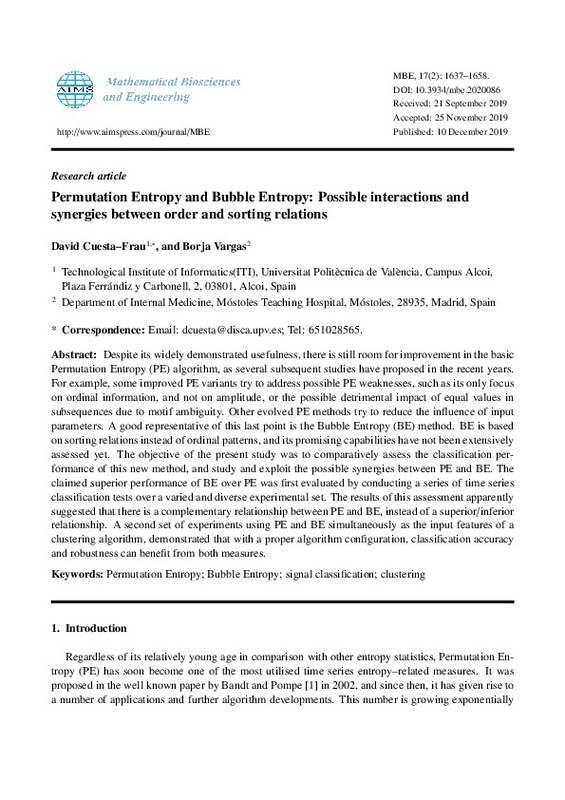1. C. Bandt and B. Pompe, Permutation entropy: A natural complexity measure for time series, <i>Phys. Rev. Lett.</i>, 88 (2002), 174102.
2. M. Zanin, L. Zunino, O. A. Rosso and D. Papo, Permutation entropy and its main biomedical and econophysics applications: A review, <i>Entropy</i>, 14 (2012), 1553-1577.
14. F. Siokis, Credit market jitters in the course of the financial crisis: A permutation entropy approach in measuring informational efficiency in financial assets, <i>Phys. A Statist. Mechan. Appl.</i>, 499 (2018).
[+]
1. C. Bandt and B. Pompe, Permutation entropy: A natural complexity measure for time series, <i>Phys. Rev. Lett.</i>, 88 (2002), 174102.
2. M. Zanin, L. Zunino, O. A. Rosso and D. Papo, Permutation entropy and its main biomedical and econophysics applications: A review, <i>Entropy</i>, 14 (2012), 1553-1577.
14. F. Siokis, Credit market jitters in the course of the financial crisis: A permutation entropy approach in measuring informational efficiency in financial assets, <i>Phys. A Statist. Mechan. Appl.</i>, 499 (2018).
15. A. F. Bariviera, L. Zunino, M. B. Guercio, L. Martinez and O. Rosso, Efficiency and credit ratings: A permutation-information-theory analysis, <i>J. Statist. Mechan. Theory Exper.</i>, 2013 (2013), P08007.
16. A. F. Bariviera, M. B. Guercio, L. Martinez and O. Rosso, A permutation information theory tour through different interest rate maturities: the libor case, <i>Philos. Transact. Royal Soc. A Math.</i> <i>Phys. Eng. Sci.</i>, 373 (2015).
20. B. Fadlallah, B. Chen, A. Keil and J. Príncipe, Weighted-permutation entropy: A complexity measure for time series incorporating amplitude information, <i>Phys. Rev. E</i>, 87 (2013), 022911.
Deng, B., Cai, L., Li, S., Wang, R., Yu, H., Chen, Y., & Wang, J. (2016). Multivariate multi-scale weighted permutation entropy analysis of EEG complexity for Alzheimer’s disease. Cognitive Neurodynamics, 11(3), 217-231. doi:10.1007/s11571-016-9418-9
24. D. Cuesta-Frau, Permutation entropy: Influence of amplitude information on time series classification performance, <i>Math. Biosci. Eng.</i>, 5 (2019), 1-16.
25. F. Traversaro, M. Risk, O. Rosso and F. Redelico, An empirical evaluation of alternative methods of estimation for Permutation Entropy in time series with tied values, <i>arXiv e-prints</i>, arXiv:1707.01517 (2017).
26. D. Cuesta-Frau, M. Varela-Entrecanales, A. Molina-Picó and B. Vargas, Patterns with equal values in permutation entropy: Do they really matter for biosignal classification?, <i>Complexity</i>, 2018 (2018), 1-15.
29. D. Cuesta-Frau, A. Molina-Picó, B. Vargas and P. González, Permutation entropy: Enhancing discriminating power by using relative frequencies vector of ordinal patterns instead of their shannon entropy, <i>Entropy</i>, 21 (2019).
30. H. Azami and J. Escudero, Amplitude-aware permutation entropy: Illustration in spike detection and signal segmentation, <i>Comput. Meth. Program. Biomed.</i>, 128 (2016), 40-51.
32. G. Manis, M. Aktaruzzaman and R. Sassi, Bubble entropy: An entropy almost free of parameters, <i>IEEE Transact. Biomed. Eng.</i>, 64 (2017), 2711-2718.
34. L. Zunino, F. Olivares, F. Scholkmann and O. A. Rosso, Permutation entropy based time series analysis: Equalities in the input signal can lead to false conclusions, <i>Phys. Lett. A</i>, 381 (2017), 1883-1892.
38. D. E. Lake, J. S. Richman, M. P. Griffin and J. R. Moorman, Sample entropy analysis of neonatal heart rate variability, <i>Am. J. Physiology-Regulatory Integrat. Comparat. Physiol.</i>, 283 (2002), R789-R797, PMID: 12185014.
41. I. Unal, Defining an Optimal Cut-Point Value in ROC Analysis: An Alternative Approach, <i>Comput. Math. Methods Med.</i>, 2017 (2017), 14.
47. A. K. Jain, M. N. Murty and P. J. Flynn, Data clustering: A review, <i>ACM Comput. Surv.</i>, 31 (1999), 264-323.
51. J. Sander, M. Ester, H.-P. Kriegel and X. Xu, Density-based clustering in spatial databases: The algorithm gdbscan and its applications, <i>Data Min. Knowl. Discov.</i>, 2 (1998), 169-194.
52. J. Wu, <i>Advances in K-means Clustering: A Data Mining Thinking</i>, Springer Publishing Company, Incorporated, 2012.
53. S. Panda, S. Sahu, P. Jena and S. Chattopadhyay, Comparing fuzzy-c means and k-means clustering techniques: A comprehensive study, in <i>Advances in Computer Science, Engineering</i> & <i>Applications</i> (eds. D. C. Wyld, J. Zizka and D. Nagamalai), Springer Berlin Heidelberg, Berlin, Heidelberg, 2012, 451-460.
54. A. L. Goldberger, L. A. N. Amaral, L. Glass, J. M. Hausdorff, P. C. Ivanov, R. G. Mark, et al., PhysioBank, PhysioToolkit, and PhysioNet: Components of a new research resource for complex physiologic signals, <i>Circulation</i>, 101 (2000), 215-220.
58. R. G. Andrzejak, K. Lehnertz, F. Mormann, C. Rieke, P. David and C. E. Elger, Indications of nonlinear deterministic and finite-dimensional structures in time series of brain electrical activity: Dependence on recording region and brain state, <i>Phys. Rev. E</i>, 64 (2001), 061907.
60. N. Iyengar, C. K. Peng, R. Morin, A. L. Goldberger and L. A. Lipsitz, Age-related alterations in the fractal scaling of cardiac interbeat interval dynamics, <i>Am. J. Physiology-Regulatory Integrat.</i> <i>Comparat. Physiol.</i>, 271 (1996), R1078-R1084, PMID: 8898003.
[-]









